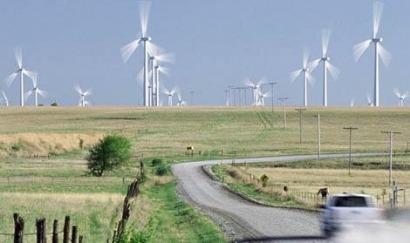
Asset finance of utility-scale renewable energy projects, such as wind farms and solar parks, jumped to a record $41.8 billion in the third quarter of 2011, according to the latest authoritative figures from research company Bloomberg New Energy Finance.
The most eye-catching feature of the third quater asset finance numbers was offshore wind, with investment secured for three large offshore wind farms in the North Sea, totalling more than 1 GW in capacity and $6.3 billion in investment. There were also big financings for photovoltaic, solar thermal and biofuel projects in the US, for a geothermal installation in Indonesia, and for onshore wind projects in Brazil and China.
Overall financial new investment in clean energy – including not just asset finance, but also equity raisings on public markets and from venture capital and private equity funds – was $45.4 billion in the third quarter of 2011, up 9% on the second quarter of this year and 16% ahead of the third quarter 2010. The record quarter for financial new investment remains the fourth quarter 2010, at $51.5 billion.
This healthy result for investment in the third quarter contrasted vividly with the performance of clean energy share prices, which fell by some 35% during the quarter, based on the performance of the WilderHill New Energy Global Innovation Index, or NEX, an index made up of 95 clean energy stocks worldwide. On 4 October, the NEX hit its lowest point since 2003; it under-performed wider indices such as the S&P 500 by a wide margin during the quarter.
Michael Liebreich, chief executive of Bloomberg New Energy Finance, said: “Over the past three years we have seen extraordinary falls in the prices of clean energy equipment – wind turbines and solar photovoltaic panels. As these figures show, this has driven up installation rates and asset investment levels. However, there is still not enough demand to soak up significant over-supply, so prices and margins have remained under pressure and manufacturers’ share prices are being crushed. The industry has swung between being a buyer’s market and a seller’s market a few times in recent years: right now, you would love to be a developer with access to funding, but not a supplier. Eventually things will come back into balance. Of course the furor in the US over the failure of Solyndra hasn’t helped clean energy share prices.”
Analysis by Bloomberg New Energy Finance, based on actual contract data, shows that the average price of PV modules has fallen by a third since autumn 2010, and by 70% since the middle of 2008, while wind turbine prices have fallen by 20% since 2009. These moves have made renewable energy technologies much more cost-competitive with fossil-fuel power sources, but have been painful for the supply chains.
The third quarter of 2011 was a record one not just for asset finance, but also for merger and acquisition activity in clean energy. M&A, including corporate and project acquisitions and refinancings, reached a total of $25.9 billion, up 31% on the second quarter of this year and 59% on the third quarter 2010. The third quarter 2011 figure was also marginally ahead of that for the fourth quarter of 2010, the previous record.
Among the big acquisition deals in the latest three months were EDF’s purchase of the 50% it did not own in its renewable energy offshoot, EDF Energies Nouvelles, for an enterprise value of $7.9 billion, and Toshiba’s takeover of Swiss electronic-metering company Landis+Gyr for $2.3 billion.
said: “The acquisitions we are seeing are only partially driven by consolidation. The low valuations for clean energy companies are giving industrial groups and utilities the opportunity to move in on a sector that they know will enjoy growth over the medium to long term,” said Liebreich.
For additional information:

